I had a wonderful time in Laos last year, and I’ve been looking forward to writing a series of posts on the Lan Xang kingdom.
When its political power peaked in the 16th and 17th centuries, it was a fascinating cultural crossroads. It imbibed influences from India (like the Ramayana, being performed above), several Thai states, Yunnan and Sri Lanka. But it was no copycat–it mixed local cultural patterns with them. This lively kingdom fused lots of thought patterns within its beautiful natural landscape–a very under-appreciated society that will reward anyone who studies it.
But it didn’t go so well after its founder, Fa Ngum, unified the local lords into one kingdom, and his son and successor, San Saenthai, centralized court administration and Buddhist practices. The next kings don’t seem to have had their ability–there were several quick royal successions.
A new king, Chakhaphat, was stronger–he reigned from 1442 to 1479, and he appointed his six sons to key political positions, and strengthened Buddhism. But the new Le dynasty in Vietnam invaded the capital, Luang Prabang. The Lao expelled them in a very costly war. But Lan Xang’s star was about to rise.
King Visoun reigned from 1501 to 1520. He centralized the court and began Lan Xang’s glory period of building monuments and monasteries. Wat Thakmo (above) was built in 1504 or 1514 by Queen Visounnarat. The current shrine is a reconstruction from the beginning of the 20th century–armies from Yunnan destroyed the original when they sacked Luang Prabang in the 1880’s. Its style is mainly Sri Lankan. It stresses mass more than Thai art does. It must have appeared very stately to Visoun’s followers. His successors would develop Lan Xang’s own style in their monuments.
Wat Thakmo was full of Buddha images before the Chinese invaders carted them off. According to John Clifford Holt, in Spirits of the Place, Visoun and his son and successor, Photthisarat (1520-48) greatly strengthened Buddhism in Lan Xang, and they integrated it with the royal court. Fa Ngum had carried Laos’ most sacred Buddha statue, the Phra Bang Buddha, from the Khmer court when he advanced north to found his empire. Visoun built a monastery that stored it, Wat Visoun (some historians think Photthisarat constructed it). The image is still considered so sacred that it’s now sheltered in the national museum–photography wasn’t allowed when I was there. The above Buddha is the principle statue in Wat Xieng Thong, which was also built in the 16th century (most people consider it Laos’ most beautiful building, and it will soon grace a separate post in this blog).
The above picture is of the 1898 reconstruction of Wat Visoun’s assembly hall–the original was torched during the Yunannese invasion. Traditionally Lao and all other Tai cultures have believed that a crowded community of spirits called phi, and serpants called nagas protect their land and communities. The Phra Bang Buddha now took over this function, and Photthisarat outlawed the old spirit cults. Like Thailand’s Emerald Buddha, the Phra Bang Buddha protects the whole kingdom. Lords pledged their loyalty to the king in front of it.
Lan Xang’s two great kings built more monasteries and invited the most scholarly monks to live in Luang Prabang and copy sacred texts. Monasteries became centers of literary culture.
They also held services that became centers of Luang Prabang’s ritual life. Buddhism became integrated with the centralizing royal court, but it also spread to the people. I took the above picture in Luang Prabang’s Wat Mahathat during a service which the monks held for the community every afternoon.
I took the above photo while facing the other direction (with the zoom on). The abbot and an assistant took turns chanting scriptures. The abbot then lectured in a deep voice. The women in the row behind me were nuns and the people behind them were locals. After the roughly hour-long service we left, and–
monks started to fill the hall for their own service. By crowding together and chanting they supposedly conentrated the Buddha’s protective power for the neighborhood, as phi and nagas had. So royal power and Buddhist orthodoxy from Sri Lanka and India spread in Lan Xang like this as it became a major Southeast Asian state.
But I was just as impressed with the nuns and lay people behind me. The crowd I sat in had a vibe that was very gentle and giving. Burning candles in that sister’s dish kept falling as their wax melted, and everyone kept reaching out to reattach their bottoms. As I looked at everyone’s bowl of offerings, it felt good to be surrounded by nothing but benevolence.
Buddhism may have been pushed from the top-down in Laos, but it was also embraced from the bottom-up. Buddhism in Laos has many dimensions which are interwoven with its rich folk cultures and family life.
But a wealth of other influences came from India and Sri Lanka–including the Ramayana and its stately dance performances. All blended with each other and with local cultures into a vibrant landscape which you’ll never forget if you immerse yourself in it. We’ll explore more of it in the next post on ancient Laos.

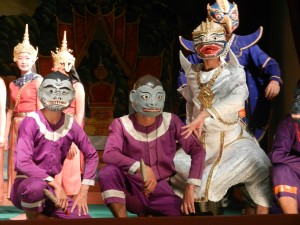
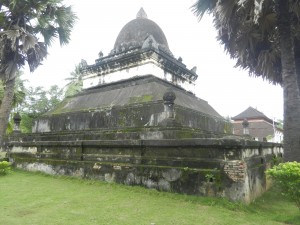
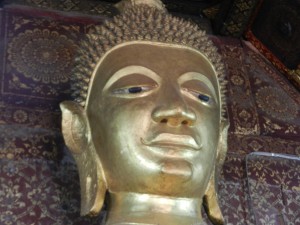
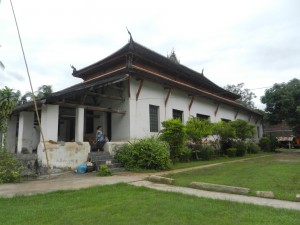
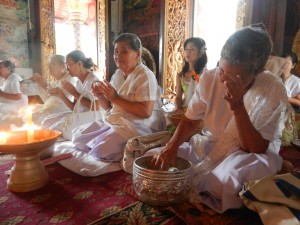
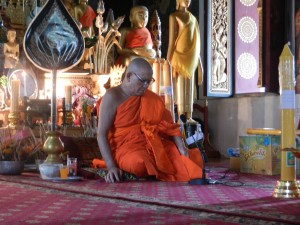
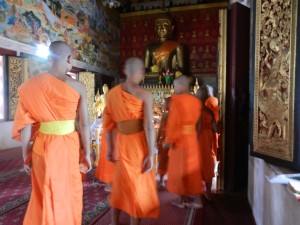
{ 3 comments }
In 1373, the royals and nobles of his own court exiled him. His son Oun Huan, often called Samsenethai , a name adopted for the 300,000 Tai people of Lan Xang; then ascended to the throne of Lan Xang. Who was barely 18 when he acceded the throne. He was named after the 1376 census, which concluded that he ruled over 300,000 Tais living in Laos; samsèn means, literally, 300,000. He set up a new administrative system based on the existing muang , nominating governors to each that lasted until it was abolished by the Communist government in 1975. Samsènthai’s death was followed by a period of unrest. Under King Xaiyachakkaphat-Phènphèo (1441-1478), the kingdom came under increasing threat from the Vietnamese. King Xaiyachakkaphat’s eldest son, the Prince of Xianglo, secured a holy white elephant. The emperor of Vietnam, learning of this momentous discovery, asked to be sent some of the beast’s hairs. Disliking the Vietnamese, the Prince dispatched a box of its excrement instead, whereupon the Emperor formed an improbably large 550,000 man army. The Prince’s army numbered 200,000 and 2,000 elephants. The massive Vietnamese army finally prevailed and entered and sacked Luang Prabang. But shortly thereafter they were driven out by Xaiyachakkaphat-Phènphèo’s son, King Souvanna Banlang (1478-1485). Peace was only fully restored under King Visounnarath (1500-1520).
The first king was K’un Borom , who lived at Teng (identified by Major Gerini as the Dasana or Doana of Ptolemy ), where a tree grew that reached to heaven, and shaded the whole district of Luang Prabang. The king used to amuse himself by going up and down between earth and heaven until the evil spirits, wishing to keep him on earth, cut down the tree. The wood of the tree is found even nowadays, and, under the name of ” Kua Kao Kat,” is, of course, used as a charm against every evil. The king planted pumpkins, and one day, to see whether a pumpkin was ripe, pierced it with an iron spear, whereupon, to his surprise, blood flowed from it. He waited a few days and then pierced another, when a black man issued forth, who became the progenitor of all the Ka Che, or Kamu . A few days later he pierced another pumpkin, when a white man came out, who became the progenitor of the Lao . In accordance with the tale the Lao look upon the Ka Che as their elder brethren.
Thanks, Lolita. There are several Lao myths about their origins. This diversity of stories and folk traditions makes it a very fun place to travel in.
Comments on this entry are closed.